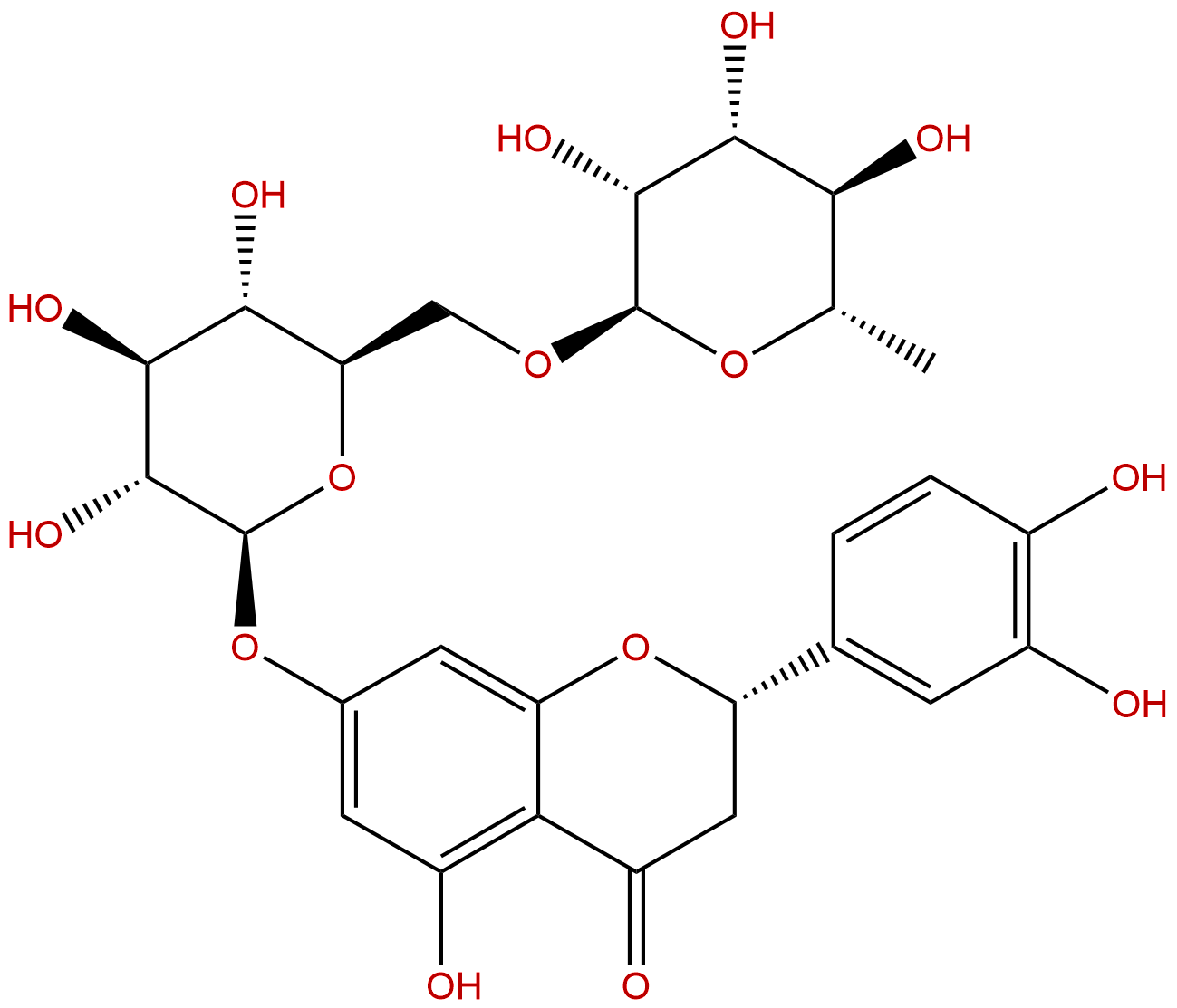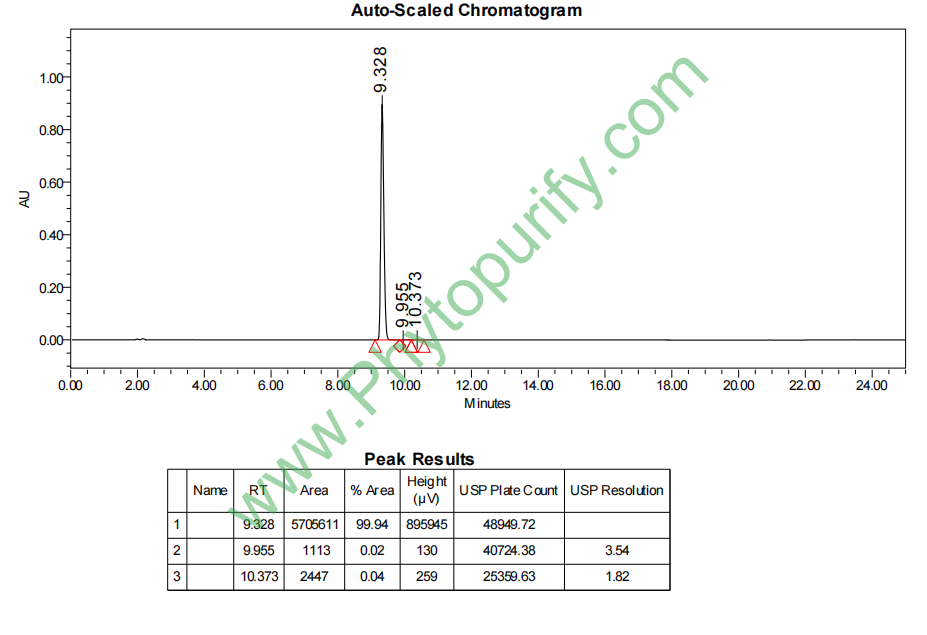
EriocitrinCAS No.:13463-28-0
|
||||||||||
 |
|
|
||||||||

| Catalogue No.: | BP0554 |
| Formula: | C27H32O15 |
| Mol Weight: | 596.538 |
Product name: Eriocitrin
Synonym name: Eriodictioside; Eriodictyol 7-rutinoside
Catalogue No.: BP0554
Cas No.: 13463-28-0
Formula: C27H32O15
Mol Weight: 596.538
Botanical Source: Aurantii fructus immaturus
Physical Description:
Type of Compound: Flavonoids
Purity: 95%~99%
Analysis Method: HPLC-DAD or/and HPLC-ELSD
Identification Method: Mass, NMR
Packing: Brown vial or HDPE plastic bottle
Storage: Store in a well closed container, protected from air and light. Put into refrigerate or freeze for long term storage.
Whenever possible, you should prepare and use solutions on the same day. However, if you need to make up stock solutions in advance, we recommend that you store the solution as aliquots in tightly sealed vials at -20℃. Generally, these will be useable for up to two weeks.
The product could be supplied from milligrams to grams
Inquire for bulk scale.
Description:
Eriocitrin is powerful antioxidative flavonoid, it can prevent oxidative damages caused by acute exercise-induced oxidative stress, it also has lipid-lowering effect in rats on a high-fat and high-cholesterol diet. Eriocitrin is a potent inhibitor of human carbonic anhydrase VA isozyme.
References:
J. Food Sci., 2006, 71(71):S633–S7.
Lipid-Lowering Effect of Eriocitrin, the Main Flavonoid in Lemon Fruit, in Rats on a High-Fat and High-Cholesterol Diet
Eriocitrin (eriodictyol 7-O-β-rutinoside) is the main flavonoid in lemon fruit.
METHODS AND RESULTS:
In this study, Eriocitrin was investigated for its lowering effect on serum and hepatic lipids in high-fat and high-cholesterol fed rats. Rats in the control group (N = 6) were fed a 20% lard and 1% cholesterol diet for 21 d, and rats in the 0.35% Eriocitrin group (N = 6) and 0.70% Eriocitrin group (N = 6) were fed a diet supplemented with Eriocitrin 0.35% and 0.70%, respectively. The content of hepatic total cholesterol and triglyceride in the Eriocitrin group was no different from that of the control group. The total cholesterol, VLDL+LDL, triglyceride, and phospholipid in the serum of the 0.35% Eriocitrin group showed significantly lower concentrations than the control group (P < 0.05), although there was no difference in the HDL concentrations among the groups. The lowering effect of Eriocitrin for serum total cholesterol was thought to be caused by a decrease in VLDL+LDL.
CONCLUSIONS:
The 0.35% Eriocitrin group was shown to have a significant increase in excretion of fecal bile acid (P < 0.05) and a tendency for enhanced hepatic m-RNA levels of LDL receptor in comparison with the control group.
Sci Rep. 2014 Jan 15;4:3708.
Eriocitrin ameliorates diet-induced hepatic steatosis with activation of mitochondrial biogenesis.
Lemon (Citrus limon) contains various bioactive flavonoids, and prevents obesity and obesity-associated metabolic diseases. We focused on Eriocitrin (eriodictyol 7-rutinoside), a powerful antioxidative flavonoid in lemon with lipid-lowering effects in a rat model of high-fat diet.
METHODS AND RESULTS:
To investigate the mechanism of action of Eriocitrin, we conducted feeding experiments on zebrafish with diet-induced obesity. Oral administration of Eriocitrin (32 mg/kg/day for 28 days) improved dyslipidaemia and decreased lipid droplets in the liver. DNA microarray analysis revealed that Eriocitrin increased mRNA of mitochondrial biogenesis genes, such as mitochondria transcription factor, nuclear respiratory factor 1, cytochrome c oxidase subunit 4, and ATP synthase. In HepG2 cells, Eriocitrin also induced the corresponding orthologues, and reduced lipid accumulation under conditions of lipid loading. Eriocitrin increased mitochondrial size and mtDNA content, which resulted in ATP production in HepG2 cells and zebrafish.
CONCLUSIONS:
In summary, dietary Eriocitrin ameliorates diet-induced hepatic steatosis with activation of mitochondrial biogenesis.
J Agric Food Chem. 2000 Aug;48(8):3217-24.
Identification and antioxidant activity of flavonoid metabolites in plasma and urine of eriocitrin-treated rats.
Eriocitrin, a flavonoid glycoside present in lemon fruit, is metabolized in vivo to a series of eriodictyol, methylated eriodictyol, 3,4-dihydroxyhydrocinnamic acid, and their conjugates.
METHODS AND RESULTS:
Plasma antioxidant activity increased following oral administration of aqueous Eriocitrin solutions to rats. Eriocitrin metabolites were found in plasma and renal excreted urine through HPLC and LC-MS analyses. Eriocitrin was not detected in plasma and urine, but eriodictyol, homoeriodictyol, and hesperetin in their conjugated forms were detected in plasma of 4.0 h following administration of Eriocitrin. In urine for 24 h, both nonconjugates and conjugates of these metabolites were detected. 3,4-Dihydroxyhydrocinnamic acid, which is metabolized from eriodictyol by intestinal bacteria, was detected in slight amounts with each form in 4.0-h plasma and 24-h urine. Eriocitrin was suggested to be metabolized by intestinal bacteria, and then eriodictyol and 3,4-dihydroxyhydrocinnamic of its metabolite were absorbed.
CONCLUSIONS:
Following administration of Eriocitrin, plasma exhibited an elevated resistance effect to lipid peroxidation. Eriocitrin metabolites functioning as antioxidant agents are discussed.
HPLC of Eriocitrin
